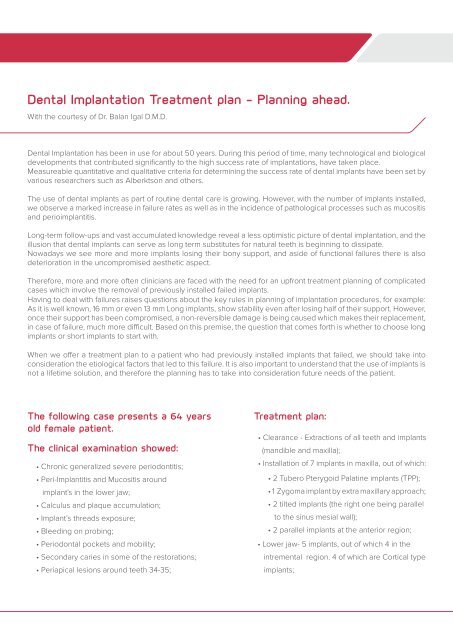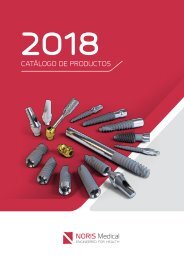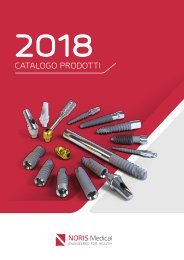Create successful ePaper yourself
Turn your PDF publications into a flip-book with our unique Google optimized e-Paper software.
Dental Implantation Treatment plan – Planning ahead.<br />
With the courtesy of Dr. Balan Igal D.M.D.<br />
Dental Implantation has been in use for about 50 years. During this period of time, many technological and biological<br />
developments that contributed significantly to the high success rate of implantations, have taken place.<br />
Measureable quantitative and qualitative criteria for determining the success rate of dental implants have been set by<br />
various researchers such as Alberktson and others.<br />
The use of dental implants as part of routine dental care is growing. However, with the number of implants installed,<br />
we observe a marked increase in failure rates as well as in the incidence of pathological processes such as mucositis<br />
and perioimplantitis.<br />
Long-term follow-ups and vast accumulated knowledge reveal a less optimistic picture of dental implantation, and the<br />
illusion that dental implants can serve as long term substitutes for natural teeth is beginning to dissipate.<br />
Nowadays we see more and more implants losing their bony support, and aside of functional failures there is also<br />
deterioration in the uncompromised aesthetic aspect.<br />
Therefore, more and more often clinicians are faced with the need for an upfront treatment planning of complicated<br />
<strong>case</strong>s which involve the removal of previously installed failed implants.<br />
Having to deal with failures raises questions about the key rules in planning of implantation procedures, for example:<br />
As it is well known, 16 mm or even 13 mm Long implants, show stability even after losing half of their support. However,<br />
once their support has been compromised, a non-reversible damage is being caused which makes their replacement,<br />
in <strong>case</strong> of failure, much more difficult. Based on this premise, the question that comes forth is whether to choose long<br />
implants or short implants to start with.<br />
When we offer a treatment plan to a patient who had previously installed implants that failed, we should take into<br />
consideration the etiological factors that led to this failure. It is also important to understand that the use of implants is<br />
not a lifetime solution, and therefore the planning has to take into consideration future needs of the patient.<br />
The following <strong>case</strong> presents a 64 years<br />
old female patient.<br />
The <strong>clinica</strong>l examination showed:<br />
• Chronic generalized severe periodontitis;<br />
• Peri-Implantitis and Mucositis around<br />
implant's in the lower jaw;<br />
• Calculus and plaque accumulation;<br />
• Implant’s threads exposure;<br />
• Bleeding on probing;<br />
• Periodontal pockets and mobility;<br />
• Secondary caries in some of the restorations;<br />
• Periapical lesions around teeth 34-35;<br />
Treatment plan:<br />
• Clearance - Extractions of all teeth and implants<br />
(mandible and maxilla);<br />
• Installation of 7 implants in maxilla, out of which:<br />
• 2 Tubero Pterygoid Palatine implants (TPP);<br />
• 1 Zygoma implant by extra maxillary approach;<br />
• 2 tilted implants (the right one being parallel<br />
to the sinus mesial wall);<br />
• 2 parallel implants at the anterior region;<br />
• Lower jaw- 5 implants, out of which 4 in the<br />
intremental region. 4 of which are Cortical type<br />
implants;
















